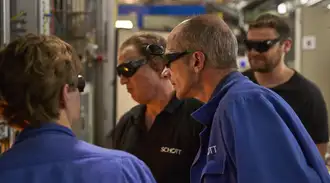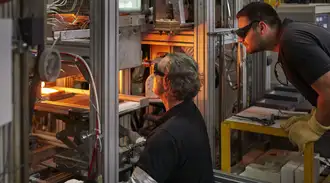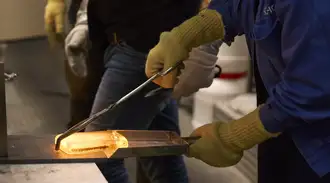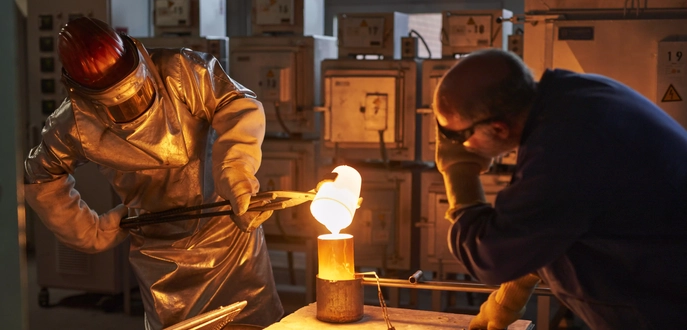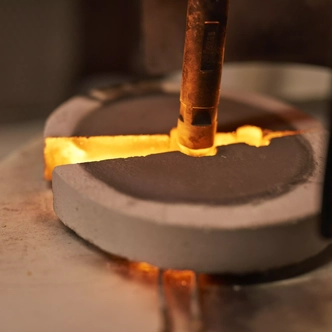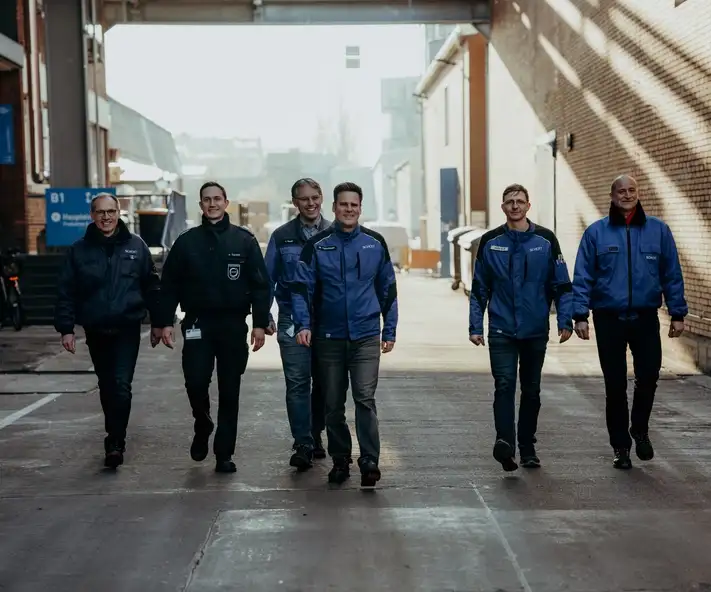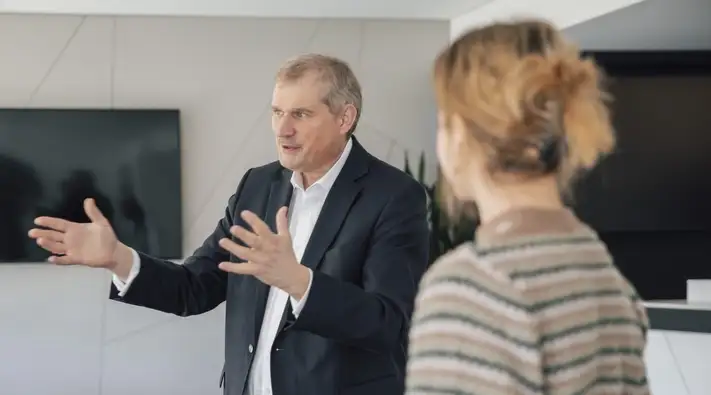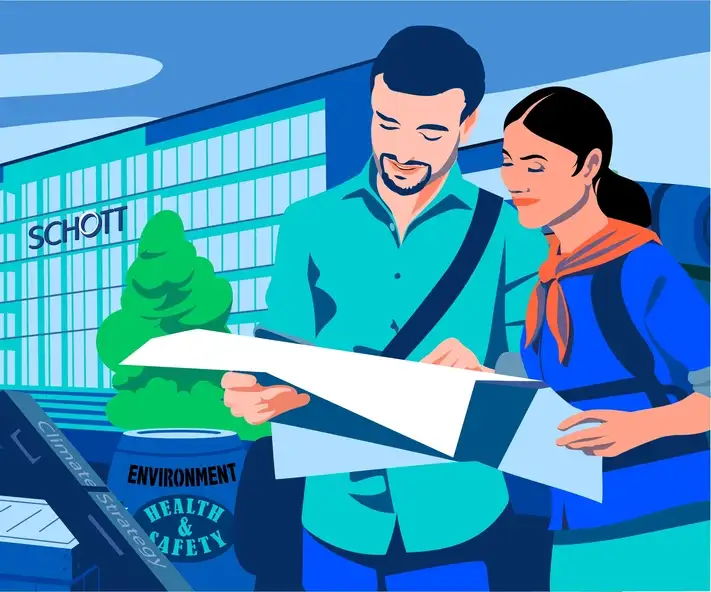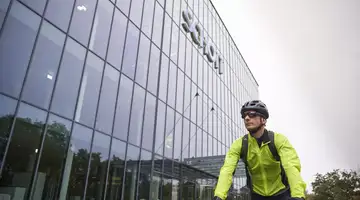
Under power
At SCHOTT's headquarters in Mainz, Germany, a team of experts has spent the past two years working on a sustainable future for the glass industry. Their mission? The electrification of the melting process. The two development projects, PROSPECT and PLANET1, intend to lay the foundation using green electricity.
SCHOTT is working on the elctrification of the glass melting process to reduce CO2 emissions and improve sustainability in the glass industry.
- The projects PROSPECT and PLANET1, which are funded by the German Federal Ministry for Economic Affairs and Climate Action, seek to power the energy-intensive glass melt with green electricity.
- Both projects investigate how to maintain the glass quality with the transition.
- The focus is on the specialty glass types boro- and aluminosilicate glass, which are used, for example, to package drugs or protect smartphones.
Shortly before seven in the morning, the sun rises over Mainz. SCHOTT's main plant, seated right next to its glassy corporate counterpart, bustles with activity. Employees pass, one after another, through two turnstiles and enter the factory premises.
Gliding through the parking lot and up to the main entrance on a mountain bike is Michael Hahn, his bright green cycling jacket standing out among the crowd. "Wonderful," he says, releasing his cycling shoes from the clipless pedals. "For me, there is no better start to the day than cycling to work."
Michael – who has been working for SCHOTT since 1994 (with one slight interruption) and lives about 30 kilometers outside Mainz – covers his commute to work on two wheels in nearly all weathers. His alarm clock rings at 5:30 a.m., and he’s in the saddle less than 30 minutes later.
"I'm not someone who takes a long time in the morning: Brush my teeth, get dressed, and I'm ready to go," the enthusiastic hobby athlete explains. "Cycling is the perfect balance to my challenging job and, simultaneously, a great way to prepare for my next competition. In addition, I protect the environment – something that is particularly close to my heart," says the 55-year-old, who, appropriately enough, is currently driving the technological change at SCHOTT as head of development for hot processes.
Unlike cycling, however, where he alone powers the machine, driving technological change is a team sport. And it's powered by electricity instead of muscle power.
"As glass industry, we are challenged"
Once he arrives at the office complex, Michael swaps his outfit for a dark blue, long-sleeved shirt, jeans, and safety shoes. Then, the early riser starts every day off with a coffee. Although he has one of the longest journeys of all his colleagues, he’s usually one of the first in the office.
"Honestly, I don't mind. I actually enjoy having the first hour of the working day to myself," says Michael, standing in the small office kitchen. After a brief pause to fill the coffee machine with water, he continues. "My daily routine is mostly determined by others later on, so I take time for myself in the morning. It's good for me because I can rethink some issues."
There have been plenty of reasons to reflect in recent years. In particular, the fact that the glass industry is one of the most energy-intensive industrial sectors in Germany has been giving him headaches for some time.
In 2020 alone, for instance, the glass industry generated in Germany about 3.9 million tons of CO2 emissions. In the melting tanks, which are heated with natural gas, raw materials are melted at temperatures up to 1,700 degrees Celsius. As such, the smelting process accounts for the largest share of energy usage.
"The climate crisis is advancing inexorably,” says Michael. “Therefore, we as the glass industry are challenged to achieve a transformation quickly." To that end, Hahn’s team has been developing new glass melting processes for the low-CO2 production of pharmaceutical glass, and other specialty glasses, in two large research projects that kicked off towards the end of 2021.
Michael says the goal is to "develop optimized melting furnaces that can be heated electrically to a large extent, while still meeting the high standards in quality for specialty glasses." It’s pioneering work for the entire industry, and on a daily basis, Michael and his team experience first-hand just how demanding the undertaking really is.
The two research and development projects, PROSPECT and PLANET1, whose total development costs amount to about 10.6 million euros, aim to electrify the melting process of glass. The German Federal Ministry for Economic Affairs and Climate Action (BMWK) has recognized the importance of this project. It is therefore funding the projects with around 4.5 million euros as part of the BMU funding program’s "Decarbonization in Industry” initiative. The program aims to reduce greenhouse gas emissions in energy-intensive industries by utilizing innovative technologies.
PROSPECT Pilot:
In the pharmaceutical sector, SCHOTT produces specialty glass for ampoules, vials, and syringes that must meet the highest quality standards. Historically, such requirements meant fully electric tank heaters could never be used. But that’s about to change.
As part of the follow-on project PROSPECT Pilot, around an additional 40 million euros are being spent on constructing and deploying an all-electric pilot furnace for the low greenhouse gas production of pharmaceutical glass. SCHOTT received grants of around 14.8 million euros for this from the Federal Ministry of Economics and Technology in October 2023. The plant, powered primarily by green electricity, could reduce greenhouse gas emissions by about 80 percent compared to the current technology.
PLANET1:
Due to an alkali content of more than ten percent, aluminosilicate glass is characterized by its outstanding physical resiliency. It’s the reason why the material is used for technical applications like the cover glass on smartphones. To reduce the large amounts of carbon dioxide released during the production of these glasses in the future, SCHOTT has been conducting research on a pilot plant for the low-CO2 production of aluminosilicate glass since January 2022. As part of the PLANET1 project, which has a total volume of around 7.44 million euros, the effort is intended to enable a melting process that is typically reliant on natural gas, to be carried out using mainly green electricity. By switching to this process, up to 60 percent of CO2 emissions could be saved.
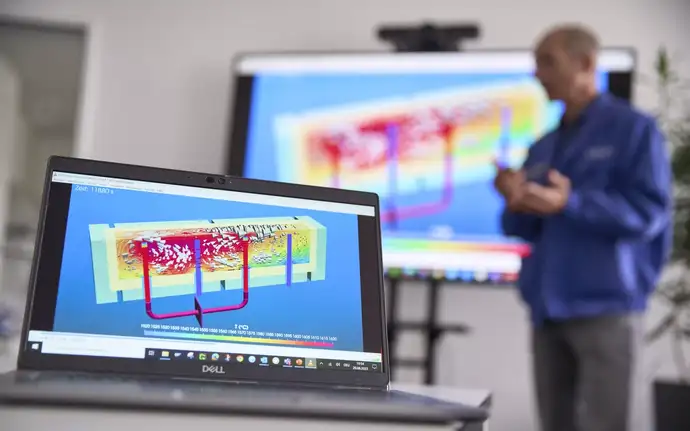
The technical center is a short walk from the office building, in a factory hall. The combination laboratory-production facility houses a fully functional melting tank built by the experts at SCHOTT... only it’s about one hundred times smaller than the real thing.
"In this case, we’re talking about a tabletop system," explains Michael. However, size does not influence the tank’s functionality. "This plant, which we can operate around the clock, is more or less the heart of our project,” Michael continues. "We can run a continuous process under certain settings, and thus be able to see, on a small scale, how electrification affects the individual phases of glass melting, and ultimately the quality of different glasses as well.”
Nothing beats glass quality
To reduce the use of fossil energy, there are several dozen electrodes made of high-temperature resistant metals in the melt, depending on the experiment. These send an electric current through the conductive material glass, releasing heat. The biggest challenge here is process control. For example, changing the fuel from natural gas to hydrogen has hardly any effect on the process. On the other hand, the installation of electrodes and the supply of more energy is a massive intervention in the melting process. "You can think of it like a weather map with the progression of low- and high-pressure areas," says Michael. "Depending on how many electrodes are heated and to what extent, this leads to different temperatures in different places and wildly swirling flow conditions."
This harbors both opportunities and risks, which is why the pilot plant is taking a close look. In the best case, electrification opens up new possibilities because an even higher temperature can be reached and a better effect achieved. In the worst case, the quality of the glass suffers, which must be avoided.

So how exactly do the pilot plant trials occur on the so-called “labmelter”? The smelter is accessed via a small ladder, which leads to a gallery about one and a half meters high. From there, a shovel fills the glass batch – a raw material mixture of up to 20 components – into the plant. As soon as the material has melted inside the tank and reached the desired temperature, a sample is taken from the front of the plant.
This is the spot where Stefan Bauer, head of the technical center responsible for setting up the test plant, is standing. Like liquid honey, he lets the glass, which has reached a temperature of up to 1,700 degrees Celsius, run out of the plant into a rectangular mold and then cuts off the luminous glass ribbon with a particular pair of scissors.
Every move is perfect. For Stefan, taking the samples has long been part of his daily routine. Next, another employee takes the glowing glass block to a lehr a few meters away where the model is allowed to cool without stress. "If we were to let the glass sample cool in the air, the cooling rates would be so high that the glass would shatter due to the high stress," Stefan explains, adding that “as soon as this process is completed, we test the glass depending on the process settings.” That means “looking for defects, testing the physical and chemical properties of the glass, and checking how it can be further processed,” he explains.
The collected test results and experiences will be incorporated into the design of the real melting tanks at a later stage. If one thing is certain, this process is a marathon, not a sprint. The people involved need stamina, making Michael the right man for the job. As an athlete who used to run triathlons, he knows precisely what it means to grit one's teeth to achieve a goal.
The same treatment for every glass
Continue a few doors down to the electrochemistry lab. This is where the foundation for the two electrification projects was laid when Ralf-Dieter Werner and Til Neidenbach conducted tests to predict the interaction between electrodes and liquid glass at an early stage.
"Due to the high temperatures, the choice of materials is minimal, so we adapt the measurements to our conditions," says Til. The first small melting tests are carried out in miniature facilities, or “crucibles.” Here, attention is paid to how the electrodes, which are later inserted into the crucibles for heating, behave when they come into contact with the hot glass. The experts then investigate how different temperatures or current strengths affect the electrode material.
"If we say that a material is suitable for a certain glass even at extremely high temperatures, that doesn't mean the same is true for other glasses," Ralf-Dieter explains, pushing his dark protective goggles onto his forehead. "We have a huge zoo of different glasses, so we must do these tests for every glass." This also explains why no pilot plant experiment is started without a green light from the lab. Another point illustrates the high importance of the lab work: the design of the large plants that will emerge from the projects in the foreseeable future will be based on engineering knowledge on the one hand, and measurements from the lab on the other.
"One area doesn't work without the other," says Michael. "What we achieve as a team is extraordinary. We all act as equals, and everyone pulls together. That's worth a lot and why it works so well." When he’s not in the office or meetings, Michael says he spends the rest of his time at the tubs. “If I don't understand what's happening on-site, I don't have a chance to supervise the development properly,” he says, “I like to lend a hand."
At the end of 2021, SCHOTT switched its production to 100 percent green electricity, achieving the first important milestone on the path to more climate protection by reducing global CO2 emissions by 60 percent. Next to natural gas, electricity is the largest energy source in terms of volume. But where does the green electricity come from? The Group takes two approaches here: On the one hand, it relies on corresponding certificates of origin (Energy Attribute Certificates, EACs), certified by recognized environmental labels. At the same time, SCHOTT uses Power Purchase Agreements (PPAs) and purchases electricity at a fixed price through direct supply contracts and long-term power purchase agreements with operators of solar and wind parks. There are currently six contracts. It is important to mention that the electricity still comes from the socket, so there is no direct line from one of the producers to Mainz.
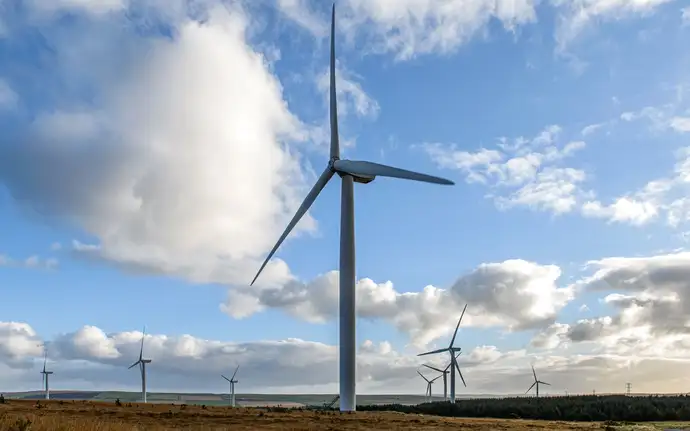
Teamwork is also the top priority in the melting laboratory. "We run a discontinuous process here," says master smelter Gunther Paulus. “Unlike in the big vats, where almost everything runs automatically, we do everything by hand."
We are talking about the individual steps of the test melts, which are carried out daily to evaluate and characterize new glass compositions from material development for the first time. At the center of the work are two identical, large gas furnaces that heat the material in small beakers up to 1,680 degrees Celsius. Using oversized tongs, Paulus removes them from the stove and pours the molten glass into a shallow container. Meanwhile, he wears a spacy, fireproof outfit consisting of a coat, helmet, and gloves.
"These furnaces are heated by fossil fuels and not electrically. But the melting laboratory does not do without electrification either, because to evaluate the final glass properties, the melt is transferred from the "gas furnaces" to electrically-heated furnaces after the raw materials have been melted down, and there it is subjected to the "second melting cycle", explains Michael, who observed the experiment. "The times between gas furnaces and electrically-heated furnaces can vary, thus developing a feeling for the optimal melting times. Currently, the gas furnaces are being modified: The conversion from energy-intensive gas/air firing to energy-saving gas/oxygen firing has already been implemented. In the near future, the furnaces will also be able to be optionally heated with gas and/or hydrogen."

Electrify as much as possible
Future being the operative word, where do we go from here? And what does the future of the glass industry look like? There likely isn’t one single solution. Michael, now back in his office, is well aware of that. And yet he shows no signs of slowing down, as evidenced by SCHOTT's two projects. "We have to find a middle ground,” says Michael. “By that, we should electrify as much as possible. The things that cannot yet be implemented electrically in terms of process technology, we have to follow up with hydrogen."
At the same time, Michael warns against rushing into things without careful consideration. "We are on a perfect path by starting work in this area early,” he says. “But if we overdo it, rush ahead completely on our own, and produce at prices that make us uncompetitive, we won't have gained anything either."
The following steps should look like this: The PROSPECT pilot project was completed in October, and the grant application for the investment project of a pilot plant has already been approved. With our support, the site in Mitterteich, Bavaria, wants to set up a pilot tank for pharmaceutical glass production that is electrically heated with green electricity by the beginning of 2027," Michael announces. "We want to extensively test this world's first electric tank over one to two years and then roll it out for production." The next step would be gradually replacing the company's existing pharmaceutical equipment. The numerous glass ceramic and borosilicate glass plants followed us. The PLANET pilot project provides the basis for electrifying the numerous aluminosilicate glass tanks as far as possible. However, we are bound to the tank repair plan to implement the necessary modifications, which only makes a gradual conversion possible and requires staying power. "Considering that we want to decarbonize our production, we still have much work ahead of us. The target will not be achievable without compensation projects, which should steadily decrease as the degree of transformation increases. But we are looking forward to this challenge because it is an exciting and elementary task in the fight against climate change," says Michael, for whom another eventful workday is ending. Before he finally goes into after-work mode, the 30-kilometer ride home still awaits him and his bike. "I can't wait to pedal hard now and completely exhaust myself." Unlike the melting tank, however, it is entirely without electric assistance and only with muscle power.
The pioneering projects are receiving funding from the German Federal Ministry of Economics and Climate Protection.
In order to decarbonize energy-intensive industries, Schott is supported by the European Union through the “NextGenerationEU” fund.




